Miercoles
Eventos economicos
Solicitudes de hipotecas
Inflacion
Ventas retail
Inventarios de nevocios
Reporte del petroleo
La decision del Fed
MBA Mortgage Applications
[Bullet7:00 AM ET
Consumer Price Index
[Report][Star]8:30 AM ET
Retail Sales
[Report][Star]8:30 AM ET
Business Inventories
[Report][djStar]10:00 AM ET
EIA Petroleum Status Report
[Star]10:30 AM ET
FOMC Meeting Announcement
[Report][Star]2:00 PM ET
FOMC Forecasts
[Star]2:00 PM ET
Fed Chair Press Conference
[Star]2:30 PM ET
Miercoles 14/06/17 La decision del Fed
62 mensajes
• Página 1 de 5 • 1, 2, 3, 4, 5
Re: Miercoles 14/06/17 La decision del Fed
Se espera que la Fed suba 0.25 puntos basicos los intereses.
- admin
- Site Admin
- Mensajes: 165593
- Registrado: Mié Abr 21, 2010 9:02 pm
Re: Miercoles 14/06/17 La decision del Fed
LAST CHANGE % CHG
Japan: Nikkei 225 19919.09 20.34 0.10%
Hang Seng 25751.82 -100.28 -0.39%
Shanghai Composite 3136.48 -17.27 -0.55%
S&P BSE Sensex 31103.49 7.79 0.03%
Australia: S&P/ASX 5814.30 41.50 0.72%
UK: FTSE 100 7500.44 -11.43 -0.15%
DJIA 21328.47 92.80 0.44%
Asia Dow 3332.63 3.19 0.10%
Global Dow 2782.77 0.30 0.01%
Japan: Nikkei 225 19919.09 20.34 0.10%
Hang Seng 25751.82 -100.28 -0.39%
Shanghai Composite 3136.48 -17.27 -0.55%
S&P BSE Sensex 31103.49 7.79 0.03%
Australia: S&P/ASX 5814.30 41.50 0.72%
UK: FTSE 100 7500.44 -11.43 -0.15%
DJIA 21328.47 92.80 0.44%
Asia Dow 3332.63 3.19 0.10%
Global Dow 2782.77 0.30 0.01%
- admin
- Site Admin
- Mensajes: 165593
- Registrado: Mié Abr 21, 2010 9:02 pm
Re: Miercoles 14/06/17 La decision del Fed
LAST(MID) CHANGE
Euro (EUR/USD) 1.1216 0.0004
Yen (USD/JPY) 110.03 -0.03
Pound (GBP/USD) 1.2745 -0.0009
Australia $ (AUD/USD) 0.7539 0.0003
Swiss Franc (USD/CHF) 0.9685 -0.0003
WSJ Dollar Index 88.28 -0.02
Futures10:57 PM EDT 6/13/2017
LAST CHANGE % CHG
Crude Oil 46.00 -0.46 -0.99%
Brent Crude 48.32 -0.40 -0.82%
Gold 1271.2 2.6 0.20%
Silver 16.885 0.118 0.70%
E-mini DJIA 21270 -10 -0.05%
E-mini S&P 500 2435.75 -2.25 -0.09%
Government Bonds11:05 PM EDT 6/13/2017
PRICE CHG YIELD
U.S. 10 Year 2/32 2.204
German 10 Year 0/32 0.269
Japan 10 Year 2/32 0.060
Euro (EUR/USD) 1.1216 0.0004
Yen (USD/JPY) 110.03 -0.03
Pound (GBP/USD) 1.2745 -0.0009
Australia $ (AUD/USD) 0.7539 0.0003
Swiss Franc (USD/CHF) 0.9685 -0.0003
WSJ Dollar Index 88.28 -0.02
Futures10:57 PM EDT 6/13/2017
LAST CHANGE % CHG
Crude Oil 46.00 -0.46 -0.99%
Brent Crude 48.32 -0.40 -0.82%
Gold 1271.2 2.6 0.20%
Silver 16.885 0.118 0.70%
E-mini DJIA 21270 -10 -0.05%
E-mini S&P 500 2435.75 -2.25 -0.09%
Government Bonds11:05 PM EDT 6/13/2017
PRICE CHG YIELD
U.S. 10 Year 2/32 2.204
German 10 Year 0/32 0.269
Japan 10 Year 2/32 0.060
- admin
- Site Admin
- Mensajes: 165593
- Registrado: Mié Abr 21, 2010 9:02 pm
Re: Miercoles 14/06/17 La decision del Fed
Commodities & Futures
10:58 PM EDT 6/13/2017
Futures LAST CHANGE % CHG
See all Futures
Crude Oil 46.00 -0.46 -0.99%
Brent Crude 48.32 -0.40 -0.82%
Natural Gas 2.974 0.008 0.27%
Gasoline 1.4877 -0.0118 -0.79%
Gold 1271.2 2.6 0.20%
Silver 16.885 0.118 0.70%
Corn 382.50 1.50 0.39%
Wheat 446.0 1.0 0.22%
E-mini DJIA 21270 -10 -0.05%
E-mini S&P 500 2435.75 -2.25 -0.09%
Indexes LAST CHANGE % CHG
TR/CC CRB Index 175.835 -0.099 -0.06%
S&P GSCI 366.90 -1.16 -0.32%
10:58 PM EDT 6/13/2017
Futures LAST CHANGE % CHG
See all Futures
Crude Oil 46.00 -0.46 -0.99%
Brent Crude 48.32 -0.40 -0.82%
Natural Gas 2.974 0.008 0.27%
Gasoline 1.4877 -0.0118 -0.79%
Gold 1271.2 2.6 0.20%
Silver 16.885 0.118 0.70%
Corn 382.50 1.50 0.39%
Wheat 446.0 1.0 0.22%
E-mini DJIA 21270 -10 -0.05%
E-mini S&P 500 2435.75 -2.25 -0.09%
Indexes LAST CHANGE % CHG
TR/CC CRB Index 175.835 -0.099 -0.06%
S&P GSCI 366.90 -1.16 -0.32%
- admin
- Site Admin
- Mensajes: 165593
- Registrado: Mié Abr 21, 2010 9:02 pm
Re: Miercoles 14/06/17 La decision del Fed
Live Spot Prices
SPOT PRICE IS OPEN
Price: US$/lb
Copper June 13,22:59
Bid/Ask 2.5757 - 2.5766
Change -0.0005 -0.02%
Low/High 2.5660 - 2.5893
Charts
Nickel June 13,22:59
Bid/Ask 3.9856 - 3.9878
Change +0.0113 +0.29%
Low/High 3.9583 - 4.0559
Charts
Aluminum June 13,22:58
Bid/Ask 0.8566 - 0.8568
Change +0.0020 +0.24%
Low/High 0.8527 - 0.8622
Charts
Zinc June 13,22:59
Bid/Ask 1.1069 - 1.1078
Change +0.0005 +0.04%
Low/High 1.0985 - 1.1183
Charts
Lead June 13,22:59
Bid/Ask 0.9341 - 0.9348
Change +0.0070 +0.76%
Low/High 0.9232 - 0.9386
Charts
Uranium Jun 05, 2017
Ux U308 price: 19.25
Change from
previous week +0.0
SPOT PRICE IS OPEN
Price: US$/lb
Copper June 13,22:59
Bid/Ask 2.5757 - 2.5766
Change -0.0005 -0.02%
Low/High 2.5660 - 2.5893
Charts
Nickel June 13,22:59
Bid/Ask 3.9856 - 3.9878
Change +0.0113 +0.29%
Low/High 3.9583 - 4.0559
Charts
Aluminum June 13,22:58
Bid/Ask 0.8566 - 0.8568
Change +0.0020 +0.24%
Low/High 0.8527 - 0.8622
Charts
Zinc June 13,22:59
Bid/Ask 1.1069 - 1.1078
Change +0.0005 +0.04%
Low/High 1.0985 - 1.1183
Charts
Lead June 13,22:59
Bid/Ask 0.9341 - 0.9348
Change +0.0070 +0.76%
Low/High 0.9232 - 0.9386
Charts
Uranium Jun 05, 2017
Ux U308 price: 19.25
Change from
previous week +0.0
- admin
- Site Admin
- Mensajes: 165593
- Registrado: Mié Abr 21, 2010 9:02 pm
Re: Miercoles 14/06/17 La decision del Fed
Trump no seguira con las politicas de Obama en Cuba, dice que solo beneficia al gobierno y no se ha hecho ningun avance en la libertad y derechos humanos de los Cubanos.
https://www.wsj.com/articles/administra ... 1497382636
https://www.wsj.com/articles/administra ... 1497382636
- admin
- Site Admin
- Mensajes: 165593
- Registrado: Mié Abr 21, 2010 9:02 pm
Re: Miercoles 14/06/17 La decision del Fed
Los gráficos del día, 
.

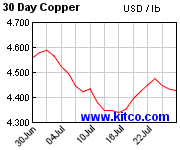
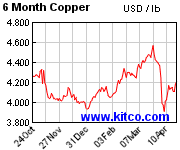
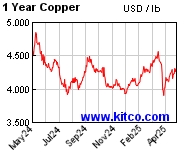
.

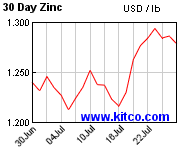
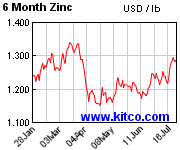
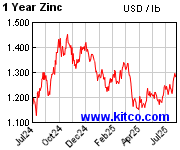
.

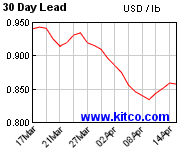
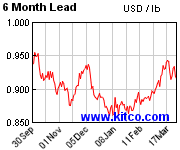
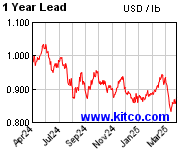
.
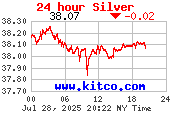
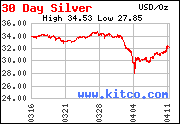
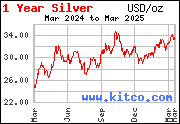
.
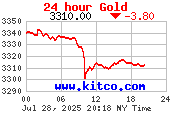
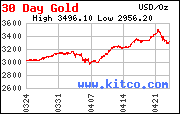
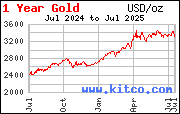
.
.




.




.




.



.



.
- Comodoro
- Mensajes: 980
- Registrado: Jue May 06, 2010 8:24 am
- Ubicación: LIMA
Re: Miercoles 14/06/17 La decision del Fed
1425.98 6.77 0.48%
Global Dow 2786.57 4.10 0.15%
Japan: Nikkei 225 19883.52 -15.23 -0.08%
Stoxx Europe 600 390.57 1.82 0.47%
UK: FTSE 100 7520.50 20.06 0.27%
CURRENCIES5:15 AM EDT 6/14/2017
LAST(MID) CHANGE
Euro (EUR/USD) 1.1210 -0.0002
Yen (USD/JPY) 110.22 0.15
Pound (GBP/USD) 1.2742 -0.0012
Australia $ (AUD/USD) 0.7579 0.0043
Swiss Franc (USD/CHF) 0.9689 0.0001
WSJ Dollar Index 88.28 -0.03
GOVERNMENT BONDS5:15 AM EDT 6/14/2017
PRICE CHG YIELD
U.S. 10 Year 3/32 2.203
German 10 Year 1/32 0.265
Japan 10 Year 0/32 0.063
FUTURES5:05 AM EDT 6/14/2017
LAST CHANGE % CHG
Crude Oil 45.96 -0.50 -1.08%
Brent Crude 48.29 -0.43 -0.88%
Gold 1270.1 1.5 0.12%
Silver 16.935 0.168 1.00%
E-mini DJIA 21296 16 0.08%
E-mini S&P 500 2438.75
Global Dow 2786.57 4.10 0.15%
Japan: Nikkei 225 19883.52 -15.23 -0.08%
Stoxx Europe 600 390.57 1.82 0.47%
UK: FTSE 100 7520.50 20.06 0.27%
CURRENCIES5:15 AM EDT 6/14/2017
LAST(MID) CHANGE
Euro (EUR/USD) 1.1210 -0.0002
Yen (USD/JPY) 110.22 0.15
Pound (GBP/USD) 1.2742 -0.0012
Australia $ (AUD/USD) 0.7579 0.0043
Swiss Franc (USD/CHF) 0.9689 0.0001
WSJ Dollar Index 88.28 -0.03
GOVERNMENT BONDS5:15 AM EDT 6/14/2017
PRICE CHG YIELD
U.S. 10 Year 3/32 2.203
German 10 Year 1/32 0.265
Japan 10 Year 0/32 0.063
FUTURES5:05 AM EDT 6/14/2017
LAST CHANGE % CHG
Crude Oil 45.96 -0.50 -1.08%
Brent Crude 48.29 -0.43 -0.88%
Gold 1270.1 1.5 0.12%
Silver 16.935 0.168 1.00%
E-mini DJIA 21296 16 0.08%
E-mini S&P 500 2438.75
- admin
- Site Admin
- Mensajes: 165593
- Registrado: Mié Abr 21, 2010 9:02 pm
Re: Miercoles 14/06/17 La decision del Fed
Copper June 14,04:59
Bid/Ask 2.5762 - 2.5771
Change +0.0000 +0.00%
Low/High 2.5660 - 2.5893
Charts
Nickel June 14,04:53
Bid/Ask 3.9992 - 4.0014
Change +0.0249 +0.63%
Low/High 3.9583 - 4.0559
Charts
Aluminum June 14,04:57
Bid/Ask 0.8554 - 0.8557
Change +0.0009 +0.11%
Low/High 0.8527 - 0.8622
Charts
Zinc June 14,04:58
Bid/Ask 1.1153 - 1.1158
Change +0.0088 +0.80%
Low/High 1.0985 - 1.1185
Charts
Lead June 14,04:58
Bid/Ask 0.9355 - 0.9361
Change +0.0084 +0.91%
Low/High 0.9232 - 0.9386
Charts
Uranium
Bid/Ask 2.5762 - 2.5771
Change +0.0000 +0.00%
Low/High 2.5660 - 2.5893
Charts
Nickel June 14,04:53
Bid/Ask 3.9992 - 4.0014
Change +0.0249 +0.63%
Low/High 3.9583 - 4.0559
Charts
Aluminum June 14,04:57
Bid/Ask 0.8554 - 0.8557
Change +0.0009 +0.11%
Low/High 0.8527 - 0.8622
Charts
Zinc June 14,04:58
Bid/Ask 1.1153 - 1.1158
Change +0.0088 +0.80%
Low/High 1.0985 - 1.1185
Charts
Lead June 14,04:58
Bid/Ask 0.9355 - 0.9361
Change +0.0084 +0.91%
Low/High 0.9232 - 0.9386
Charts
Uranium
- admin
- Site Admin
- Mensajes: 165593
- Registrado: Mié Abr 21, 2010 9:02 pm
Re: Miercoles 14/06/17 La decision del Fed
7522.37 21.93 0.29%
Germany: DAX 12821.61 56.63 0.44%
France: CAC 40 5304.86 43.12 0.82%
Stoxx Europe 600 390.61 1.86 0.48%
Hang Seng 25875.90 23.80 0.09%
Japan: Nikkei 225 19883.52 -15.23 -0.08%
DJIA 21328.47 92.80 0.44%
Europe Dow 1785.09 7.56 0.43%
Global Dow
Germany: DAX 12821.61 56.63 0.44%
France: CAC 40 5304.86 43.12 0.82%
Stoxx Europe 600 390.61 1.86 0.48%
Hang Seng 25875.90 23.80 0.09%
Japan: Nikkei 225 19883.52 -15.23 -0.08%
DJIA 21328.47 92.80 0.44%
Europe Dow 1785.09 7.56 0.43%
Global Dow
- admin
- Site Admin
- Mensajes: 165593
- Registrado: Mié Abr 21, 2010 9:02 pm
Re: Miercoles 14/06/17 La decision del Fed
Global Oil Glut Won’t Subside in 2017, Says IEA
OPEC’s efforts to rein in supply are taking longer than expected as U.S. oil producers see rebound
Summer SaidJune 14, 2017 4:00 a.m. ET
Mobile offshore drilling units in Cromarty, U.K. The IEA’s data on high storage levels indicate that there is more oil in the world than can be consumed.
Mobile offshore drilling units in Cromarty, U.K. The IEA’s data on high storage levels indicate that there is more oil in the world than can be consumed. Photo: Chris Ratcliffe/Bloomberg News
By
Summer Said
The global oil glut is here to stay through 2017 as OPEC’s efforts to restrain petroleum production have hit a wall in the U.S., the International Energy Agency said Wednesday.
In its closely watched monthly oil market report, the IEA said the world’s vast levels of stored oil—a proxy for the global oversupply—grew by 18.6 million barrels in April in industrialized nations. Those inventories were 292 million barrels higher than the five-year average, said the IEA, which advises governments on energy trends.
The high storage levels are a sign that there is more oil in the world than can be consumed, helping depress crude prices at levels lower than desired by oil producers in the Organization of the Petroleum Exporting Countries, the 14-nation cartel that controls about 40% of global crude output.
OPEC teamed up with 10 other big producers outside the cartel to cap their production through March 2018 at roughly 1.8 million barrels a day lower than levels in October 2016.
But the IEA said the effort is taking longer than expected, in part because U.S. oil producers have come roaring back to life this year. The IEA said it expects U.S. crude supply to grow by 430,000 barrels a day this year, and will grow by 780,000 barrels a day in 2018.
“Such is the dynamism of this extraordinary, very diverse industry it is possible that growth will be faster,” the IEA said.
OPEC members Libya and Nigeria have also increased production, as allowed under the cartel’s output deal because their oil industries had faced violent disruptions. OPEC crude oil output rose by 29,000 barrels a day in May to 32.08 million barrels a day, the highest level so far this year.
If current trends hold, stored oil will begin dropping this year but it won’t fall to the five-year average—a key goal of OPEC—until March 2018, when the production deal ends.
“We have regularly counseled that patience is required on the part of those looking for the rebalancing of the oil market,” the IEA said.
Saudi Arabia’s energy minister Khalid al-Falih has said that the producer coalition is determined to do “whatever it takes” to achieve the of bringing stock levels back to the five-year average.
“‘Whatever it takes’ might be the mantra, but the current form of ‘whatever’ is not having as quick an impact as expected,” the IEA said.
Despite relatively low oil prices, producers are still pumping healthy amounts of oil, the IEA said.
Total production from producers outside OPEC is expected to grow by 700,000 barrels this year and 1.5 million barrels in 2018, which is slightly more than the expected increase in global demand. Last month alone, global oil supply rose by 585,000 barrels a day as both OPEC and non-OPEC countries produced more.
Write to Summer Said at summer.said@wsj.com
OPEC’s efforts to rein in supply are taking longer than expected as U.S. oil producers see rebound
Summer SaidJune 14, 2017 4:00 a.m. ET
Mobile offshore drilling units in Cromarty, U.K. The IEA’s data on high storage levels indicate that there is more oil in the world than can be consumed.
Mobile offshore drilling units in Cromarty, U.K. The IEA’s data on high storage levels indicate that there is more oil in the world than can be consumed. Photo: Chris Ratcliffe/Bloomberg News
By
Summer Said
The global oil glut is here to stay through 2017 as OPEC’s efforts to restrain petroleum production have hit a wall in the U.S., the International Energy Agency said Wednesday.
In its closely watched monthly oil market report, the IEA said the world’s vast levels of stored oil—a proxy for the global oversupply—grew by 18.6 million barrels in April in industrialized nations. Those inventories were 292 million barrels higher than the five-year average, said the IEA, which advises governments on energy trends.
The high storage levels are a sign that there is more oil in the world than can be consumed, helping depress crude prices at levels lower than desired by oil producers in the Organization of the Petroleum Exporting Countries, the 14-nation cartel that controls about 40% of global crude output.
OPEC teamed up with 10 other big producers outside the cartel to cap their production through March 2018 at roughly 1.8 million barrels a day lower than levels in October 2016.
But the IEA said the effort is taking longer than expected, in part because U.S. oil producers have come roaring back to life this year. The IEA said it expects U.S. crude supply to grow by 430,000 barrels a day this year, and will grow by 780,000 barrels a day in 2018.
“Such is the dynamism of this extraordinary, very diverse industry it is possible that growth will be faster,” the IEA said.
OPEC members Libya and Nigeria have also increased production, as allowed under the cartel’s output deal because their oil industries had faced violent disruptions. OPEC crude oil output rose by 29,000 barrels a day in May to 32.08 million barrels a day, the highest level so far this year.
If current trends hold, stored oil will begin dropping this year but it won’t fall to the five-year average—a key goal of OPEC—until March 2018, when the production deal ends.
“We have regularly counseled that patience is required on the part of those looking for the rebalancing of the oil market,” the IEA said.
Saudi Arabia’s energy minister Khalid al-Falih has said that the producer coalition is determined to do “whatever it takes” to achieve the of bringing stock levels back to the five-year average.
“‘Whatever it takes’ might be the mantra, but the current form of ‘whatever’ is not having as quick an impact as expected,” the IEA said.
Despite relatively low oil prices, producers are still pumping healthy amounts of oil, the IEA said.
Total production from producers outside OPEC is expected to grow by 700,000 barrels this year and 1.5 million barrels in 2018, which is slightly more than the expected increase in global demand. Last month alone, global oil supply rose by 585,000 barrels a day as both OPEC and non-OPEC countries produced more.
Write to Summer Said at summer.said@wsj.com
- admin
- Site Admin
- Mensajes: 165593
- Registrado: Mié Abr 21, 2010 9:02 pm
Re: Miercoles 14/06/17 La decision del Fed
Un hombre blanco de mediana edad dispara con un rifle a la practica de baseball de los republicanos, miembros del Congreso en Virginia. El tercer hombre mas poderoso del Congreso es herido en la cadera. Hubieron 50 disparos y varios heridos.
https://www.wsj.com/articles/rep-steve- ... 1497442320
https://www.wsj.com/articles/rep-steve- ... 1497442320
- admin
- Site Admin
- Mensajes: 165593
- Registrado: Mié Abr 21, 2010 9:02 pm
Re: Miercoles 14/06/17 La decision del Fed
Oil down 46.11
Los futures del Dow Jones 31 puntos al alza.
Au up 1,276
Europa al alza.
Los futures del Dow Jones 31 puntos al alza.
Au up 1,276
Europa al alza.
- admin
- Site Admin
- Mensajes: 165593
- Registrado: Mié Abr 21, 2010 9:02 pm
Re: Miercoles 14/06/17 La decision del Fed
LAST(MID) CHANGE
Euro (EUR/USD) 1.1266 0.0055
Yen (USD/JPY) 109.42 -0.64
Pound (GBP/USD) 1.2784 0.0030
Australia $ (AUD/USD) 0.7624 0.0088
Swiss Franc (USD/CHF) 0.9661 -0.0027
WSJ Dollar Index 87.87 -0.44
Futures8:42 AM EDT 6/14/2017
LAST CHANGE % CHG
Crude Oil 46.11 -0.35 -0.75%
Brent Crude 48.47 -0.25 -0.51%
Gold 1275.4 6.8 0.54%
Silver 17.045 0.278 1.66%
E-mini DJIA 21315 35 0.16%
E-mini S&P 500 2440.75 2.75 0.11%
Government Bonds8:52 AM EDT 6/14/2017
PRICE CHG YIELD
U.S. 10 Year 18/32 2.148
German 10 Year 7/32 0.246
Japan 10 Year 0/32 0.063
Euro (EUR/USD) 1.1266 0.0055
Yen (USD/JPY) 109.42 -0.64
Pound (GBP/USD) 1.2784 0.0030
Australia $ (AUD/USD) 0.7624 0.0088
Swiss Franc (USD/CHF) 0.9661 -0.0027
WSJ Dollar Index 87.87 -0.44
Futures8:42 AM EDT 6/14/2017
LAST CHANGE % CHG
Crude Oil 46.11 -0.35 -0.75%
Brent Crude 48.47 -0.25 -0.51%
Gold 1275.4 6.8 0.54%
Silver 17.045 0.278 1.66%
E-mini DJIA 21315 35 0.16%
E-mini S&P 500 2440.75 2.75 0.11%
Government Bonds8:52 AM EDT 6/14/2017
PRICE CHG YIELD
U.S. 10 Year 18/32 2.148
German 10 Year 7/32 0.246
Japan 10 Year 0/32 0.063
- admin
- Site Admin
- Mensajes: 165593
- Registrado: Mié Abr 21, 2010 9:02 pm
62 mensajes
• Página 1 de 5 • 1, 2, 3, 4, 5
¿Quién está conectado?
Usuarios navegando por este Foro: No hay usuarios registrados visitando el Foro y 25 invitados
